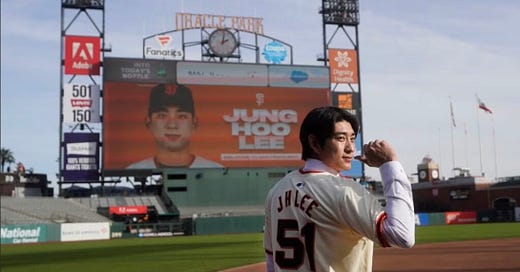Don't look back
With several 2023 cellar dwellers spending this winter, someone may be gaining on you

The Kansas City Royals, who won 56 games in 2023, committed $105 million to 6 free agents in a recent 2-week span, locking up right-handed starters Michael Wacha (2 years, $32 million) and Seth Lugo (3 years, $45 million); relievers Will Smith (one year, $5 million) and Chris Stratton (2 years, $8 million); outfielder Hunter Refroe (2 years, $13 million) and former Marlins utility man Garrett Hampson (one year, $2 million).
The 78-win Detroit Tigers yesterday signed former Cardinals righthander Jack Flaherty to a one-year deal worth $14 million after previously signing another starter, Kenta Maeda, for $24 million over 2 seasons and reliever Andrew Chafin for one year and $4.75 million. They also took on the final year and $11.5 million on outfielder Mark Canha’s contract in a trade with the Brewers earlier this winter.
The 71-win Cardinals wasted no time addressing their starting pitching shortage this offseason, pouncing on veteran innings eaters Kyle Gibson (one year, $13 million), Sonny Gray (3 years, $75 million) and Lance Lynn (one year, $11 million), all before the Winter Meetings.
The 79-win Giants made one of the biggest splashes of the offseason to date, signing highly touted Korean center fielder Jung Hoo Lee for 6 years and $113 million before inking veteran catcher Tom Murphy for 2 years and a guaranteed $8.25 million.
The D-Backs, who matched the Marlins with 84 wins last season but rode their Wild Card to the National League pennant, acquired powerful third baseman Eugenio Suarez and the $13 million left on his contract from the Mariners, while also diving head-first into free agency to bring in outfielder/DH Lourdes Gurriel Jr. for 3 years and $42 million and lefthander Eduardo Rodriguez for 4 years and $80 million.
The 82-win Reds have already committed $87 million to 3 free agents this winter: third baseman Jeimer Candelario (3 years, $45 million), right-handed starter Nick Martinez (2 years, $26 million) and righty bullpen arm Emilio Pagan (2 years, $16 million).
The 76-win Pirates have re-signed outfielder Andrew McCutchen (one year, $5 million) and bulked up their rotation by signing lefty Martin Perez to a one-year, $8 million deal and by acquiring former Mariners lefthander Marco Gonzales, due $12.25 million in 2024.
The 75-win Mets have added former Yankee Luis Severino to their rotation on a one-year deal worth $13 million, and they’re reported to be in play for the biggest free agent arm on the market this winter, 25-year-old Japanese sensation Yoshinobu Yamamoto.
Meanwhile, the 71-win Nationals have been quiet so far, merely adding third baseman Nick Senzel for a year at $2 million and reliever Dylan Floro for a year at $2.25 million. But a report surfaced out of the Winter Meetings that they could pursue former Phillies first baseman Rhys Hoskins or former Marlins DH Jorge Soler.
That’s 9 teams (7 in the National League alone), none of whom won more games than the Marlins in 2023, combining to take on 27 players at a cost of nearly $645 million in an effort to leapfrog the Marlins and other teams like them to reach the playoffs in 2024 and beyond.
And if you think about it, nearly any of the players mentioned above—some of whom signed for a relative pittance—could have helped a Marlins team in search of more offense, desperate for power, looking to beef up its bullpen and in need of more starting pitching (no matter what some of the casuals say).
For the Marlins, the immediate threat is not the Braves, Phillies and Dodgers—the teams everyone in the NL is chasing.
Before they can even dream about battling those clubs, they have to work to stay ahead of the teams mentioned above, and others like them, who are actively trying to improve in both the short and long term.
After celebrating their first trip to the playoffs in a full season in 20 years this past season, the Marlins’ offseason to this point has amounted to replacing Kim Ng atop the baseball operations hierarchy with Peter Bendix, most likely saying goodbye to 36-home run slugger Jorge Soler and adding 4 players with previous big league experience—none a frontliner: catcher Christian Bethancourt, utility man Vidal Brujan and righthanders Kaleb Ort and Calvin Faucher.
The cumulative career WAR of those 4, according to Baseball Reference, is -2.0 in a total of 550 career games, placing their career-long contributions at the big league level more or less on a par with what Jean Segura gave the Marlins over 85 dreadful games in 2023, a WAR of -1.9.
I’ve written previously about how replacing Ng with Bendix means a likely organizational reset, even if no one with the Marlins will acknowledge that publicly. I’ve also written that that may not be the worst thing.
But for an organization that has spent more than 3 decades searching for relevance in Major League Baseball and, more importantly, among potential ticket buyers in South Florida, kicking the can down the road in year 7 of Bruce Sherman’s ownership comes with serious risk.
Not aggressively (or even meekly) working to build upon the on-field gains of 2023, which translated into a modest increase in attendance the club proudly celebrated, is a fraught proposition.
A lot of people who came to a ballgame or 2 for the first time in a while in 2023 can easily be reminded of why they had previously stayed away from loanDepot park in droves if the new year comes with a sizable step backward in the standings.
Remember why the Marlins made the playoffs in 2023:
They had unfathomable—and unsustainable—good fortune in one-run games, going 33-14.
And they piled up victories against teams at the bottom of the standings. In fact, nearly half of their wins in 2023 (38 of 84) came against the 9 teams I mentioned at the beginning of this piece.
All of those teams have taken strides forward this winter. Several of them have taken significant strides forward.
The only notable changes to the Marlins’ roster in the 2 1/2 months since the end of their season: likely losing their best power hitter to free agency and replacing light-hitting part-time catcher Jacob Stallings with lighter-hitting (but strong-armed) part-time catcher Christian Bethancourt.
I get it. They’re playing the long game. While they can’t acknowledge it when they’re trying to convince you to “give the gift of Marlins beisbol” this holiday season, they really are entering another rebuild on Bendix’s watch even with the tenuousness of the long-term health and viability of Major League Baseball in South Florida.
While the Marlins seemingly forego the opportunity to build on last year’s surprising success, several 2023 bottom feeders are spending in an effort to have their own surprising success in 2024.
And if the Marlins aren’t careful, they’ll see several of those clubs zooming by them on the left, in the passing lane.
While you’re here…
Your feedback is always appreciated. Hit the “LIKE” button below if you enjoyed this post.
Interested in advertising on VIEW FROM THE BLEACHERS? Contact me here to learn about opportunities to promote your business on a daily or weekly basis.
Learn more about one-on-one play-by-play coaching from Glenn Geffner via Zoom at glenngeffner.com and, for a limited time, take advantage of a special holiday discount if you register today.







I've enjoyed your blog. As a lifelong baseball and longtime Marlins fan, I am happy with the hire of Peter Bendix. Finally, leadership with a proven track record of success in a market similar to Miami. This is what the organization really needed. As far as 2023, I agree it was a bit of a fluke. Basically they got lucky and beat up on lesser teams. They played poorly all year against the better teams. As for 2024, they are probably going to be around a .500 team. I will be surprised if they sign anyone of consequence. Besides, it's time to find out if Jacob Amaya can be an every day shortstop, if Xavier Edwards and Troy Johnstons superb minor league careers can translate into steady production at the MLB level,. Then there's Peyton Burdick who hasn't been able to hit for average any where but certainly has power and is an okay outfielder. Don't forget the stockpile of young pitchers, both starters and relievers. I am more concerned about defense then anything else. The bottom line is the Marlins are going to go as far as their pitching takes them. It makes no sense to put people in the field who can't catch the ball. I don't care what the analytics say. Loan Depot Park is a pitchers park anyway. Why can't the organization build their teams around pitching, speed, and defense? While that probably won't win many championships, at this point, that goal isn't realistic. A team that is competitive every year, that makes the playoffs many of those years will start to develop credibility and a fan base. So I think the organization is finally on the right track.
Forbes magazine noted the Ohtani deferral, while "legal," further tilts an already uneven playing field in MLB. This is another reason why LA and other top teams must not win (it removes CBT money). The most compelling wins are from super underdogs.I feel the most sadness for middling teams that try to play the game full out on this ridiculously skewed system, such as the Reds. They just keep getting hit upside the head with their terrible FA choices and never learn. Others, such as the Pirates and Royals, act for show to deflect union criticism while they try to catch a random wave every once in a while. Even heavily lauded Atlanta and the chronic playoff disappointment Dodgers have just one title in the last 25 years or 35 years, respectively. Spending $200m plus? Maybe fans of the Dodgers and Braves feel better with their increasingly irrelevant regular seasons showings, but I doubt it. Quite the opposite.